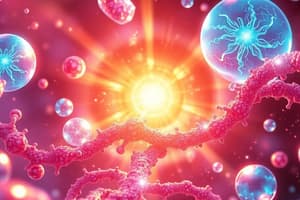Podcast
Questions and Answers
What is the main advantage of inhalation administration?
What is the main advantage of inhalation administration?
- Rapid onset and elimination of the drug (correct)
- Avoidance of first pass metabolism
- Easy administration method
- Cost-effective compared to other methods
Which of the following is NOT a route of administration?
Which of the following is NOT a route of administration?
- Oral (correct)
- Intraperitoneal
- Transdermal
- Intrathecal
What is the purpose of intracardiac injection?
What is the purpose of intracardiac injection?
- To administer adrenaline (correct)
- To administer amphotericine B
- To administer cortisone
- To administer anaesthesia
What is the advantage of transdermal administration?
What is the advantage of transdermal administration?
What is the purpose of intrathecal administration?
What is the purpose of intrathecal administration?
What is the benefit of intraperitoneal administration?
What is the benefit of intraperitoneal administration?
What is the purpose of intra-articular administration?
What is the purpose of intra-articular administration?
What is the benefit of inhalation administration over oral administration?
What is the benefit of inhalation administration over oral administration?
What is the purpose of transdermal patches?
What is the purpose of transdermal patches?
What is the purpose of intra-arterial administration?
What is the purpose of intra-arterial administration?
Flashcards
Pharmacology
Pharmacology
Study of drugs, their effects on cells, and mechanisms of action.
Pharmacokinetics
Pharmacokinetics
The study of the rate of drug absorption including distribution, metabolism, and excretion (ADME).
Pharmacodynamics
Pharmacodynamics
The study of what drugs do to the body (pharmacological effects) and how they do it (mechanism of drug action).
Tablets
Tablets
Solid form for oral use, swallowed with water.
Signup and view all the flashcards
Capsules
Capsules
Solid dosage form with hard or soft gelatin shell, for oral use or inhalation.
Signup and view all the flashcards
Creams
Creams
Aqueous, non-greasy semi-solid for skin absorption.
Signup and view all the flashcards
Ointments
Ointments
Semi-solid, greasy preparation for skin, rectum, or nasal mucosa.
Signup and view all the flashcards
Suppositories
Suppositories
Solid medicated preparations for rectal insertion.
Signup and view all the flashcards
Solutions
Solutions
Homogenous mixture of solute and solvent.
Signup and view all the flashcards
Syrups
Syrups
Concentrated aqueous solutions of sugar.
Signup and view all the flashcardsStudy Notes
Pharmacology
- Deals with drugs, how they affect cells, and their mechanisms of action
- Divisions of general pharmacology: Pharmacokinetics, Pharmacodynamics, and Pharmacotherapeutic process
Pharmacokinetics
- The study of the rate of absorption of drug molecules
- Includes distribution of the drug within the body, metabolism, and excretion (ADME)
Pharmacodynamics
- What drugs do to the body (pharmacological effects)
- How drugs do it (mechanism of drug action)
Sources of Drugs
- Plants (e.g., Belladonna, Atropine, Digitalis, Ephedrine)
- Animals (e.g., Pig and bovine Insulin)
- Microorganisms (e.g., Penicillin, Streptomycin)
- Minerals (e.g., Iron preparations)
- Synthetic drugs (most drugs)
Dosage Forms
Solid Dosage Forms
- Tablets (oral administration, swallowed with water)
- Capsules (hard or soft gelatin shell, for oral use or inhalation)
- Powders (bulk or divided, for internal use)
Semi-solid Dosage Forms
- Creams (aqueous, non-greasy, for skin or Percutaneous absorption)
- Ointments (semi-solid, greasy, for skin, rectum, or nasal mucosa)
- Pastes
- Gels
Molded Solid Dosage Forms
- Suppositories (solid medicated preparations for rectal insertion)
- Pessaries (solid medicated preparations for vaginal insertion)
Liquid Dosage Forms
- Solutions (homogenous mixture of solute and solvent)
- Suspensions
- Emulsions
Types of Solutions
- Syrups (concentrated aqueous solutions of sugar)
- Elixirs (sweetened hydro-alcoholic solutions)
- Tinctures (alcoholic or hydro-alcoholic solutions containing herbal extracts)
- Gargles (aqueous solutions for prevention or treatment of throat infections)
- Mouthwashes (similar to gargles, for oral hygiene and infection treatment)
- Nasal solutions (aqueous solutions for local or systemic effects)
Administration of Drugs
- Factors governing the choice of administration route: physical and chemical nature of the drug, rate of absorption, site of action, onset of action, patient condition, and effects of GIT juices, enzymes, and first-pass metabolism
- Routes of administration:
- Oral administration
- Sublingual (rapid absorption, avoids GIT enzymes and first-pass metabolism)
- Intravenous
- Intra-arterial
- Intracardiac
- Intrathecal
- Intra-articular
- Inhalation
- Transdermal (through skin)
- Ophthalmic (in the eye)
Let me know if you'd like me to reformat or add anything!
Studying That Suits You
Use AI to generate personalized quizzes and flashcards to suit your learning preferences.




